Divergence
Divergence is inspired by sci-fi aesthetics and real physics and questions the way we perceive our surroundings. In particular, it deals with the question of how to create physicality in order to demonstrate and sense the invisible forces that surround us. For that reason, the project proposes the creation of a wearable Electromagnetic Field (EMF) detector that provides the human body with the ability to feel and hear the electrically and magnetically charged particles that propagate around us in the form of waves. The wearable consists of a soft-circuitry garment with an embedded Adafruit Flora microcontroller that provides haptic and sonic feedback of the electromagnetic sources that surround us. The haptic feedback is experienced in the form of vibration patterns and the sonic feedback in the form of tones that variate in pitch depending on the strength of the signal. The detection takes place through the creation of two embroidered coils that are incorporated in the wrists of the garment and serve as “antennas” for sensing EM fields. The vibration is created by a small vibration motor incorporated in the chest and the sound is transmitted through a pair of headphones that can be attached to the collar of the garment. The zipper provides a low-pass filter and volume control for headphones.
Divergence has been presented in numerous iterations as both a sound performance and an audiovisual installation.
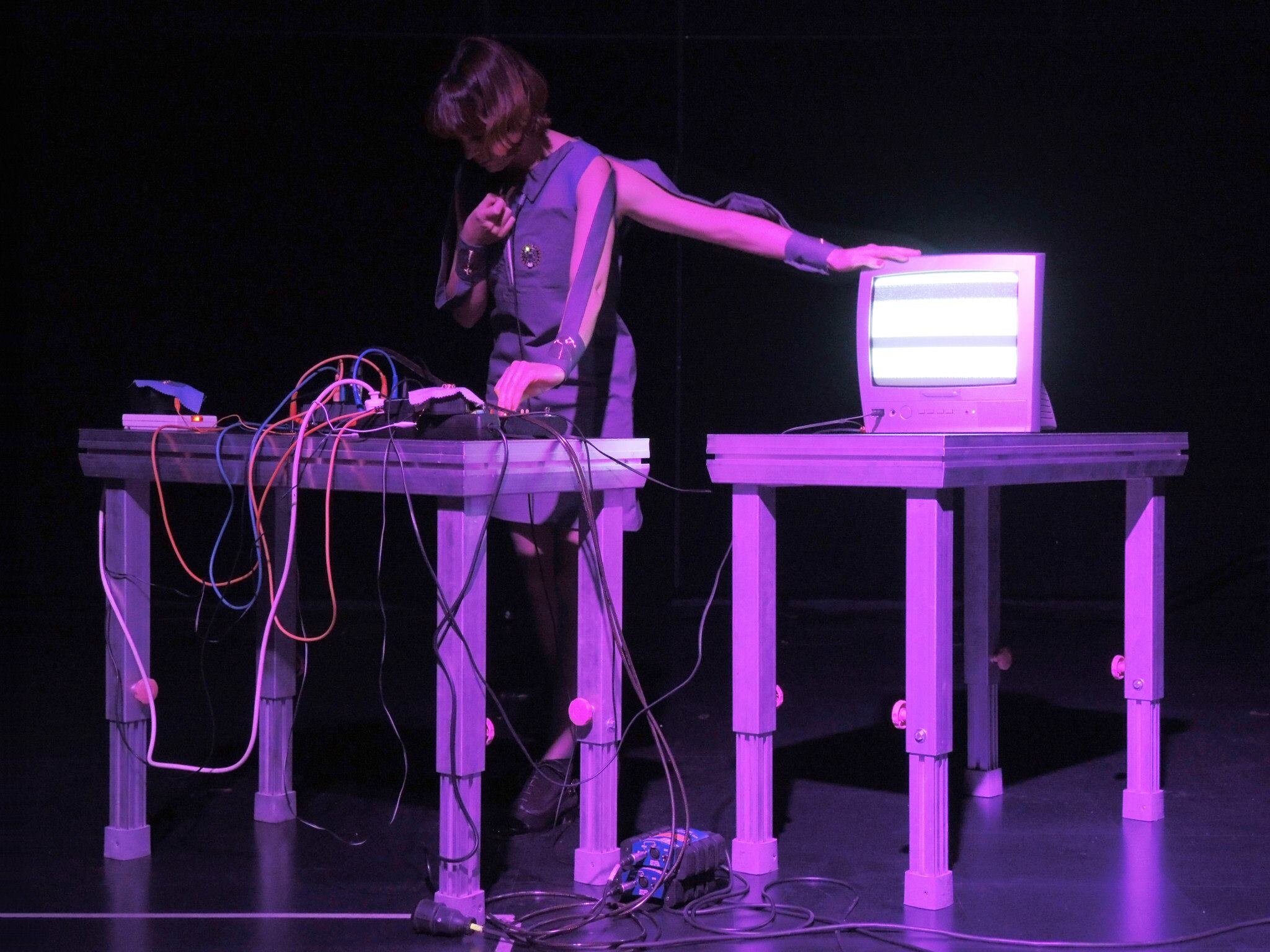
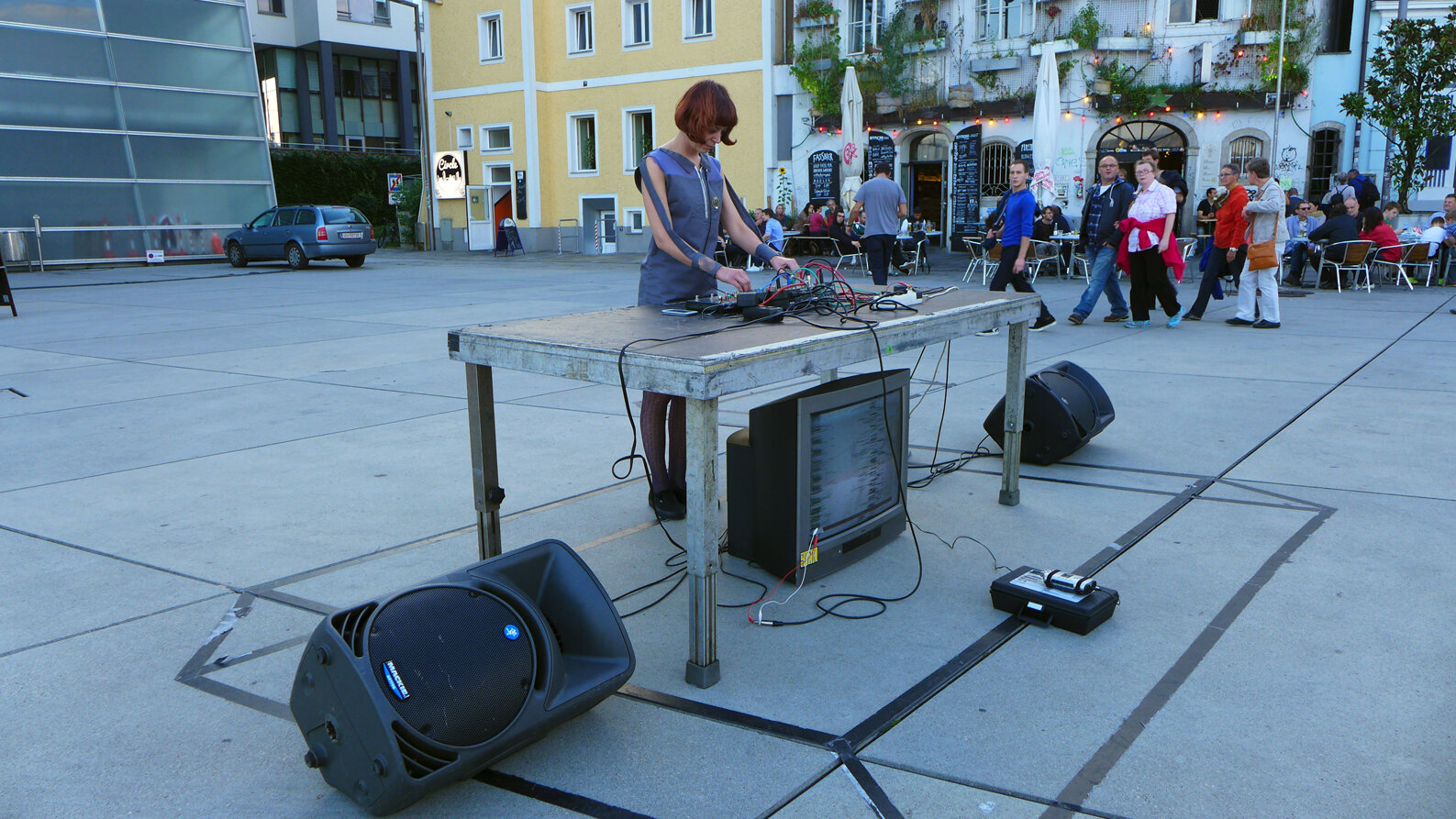
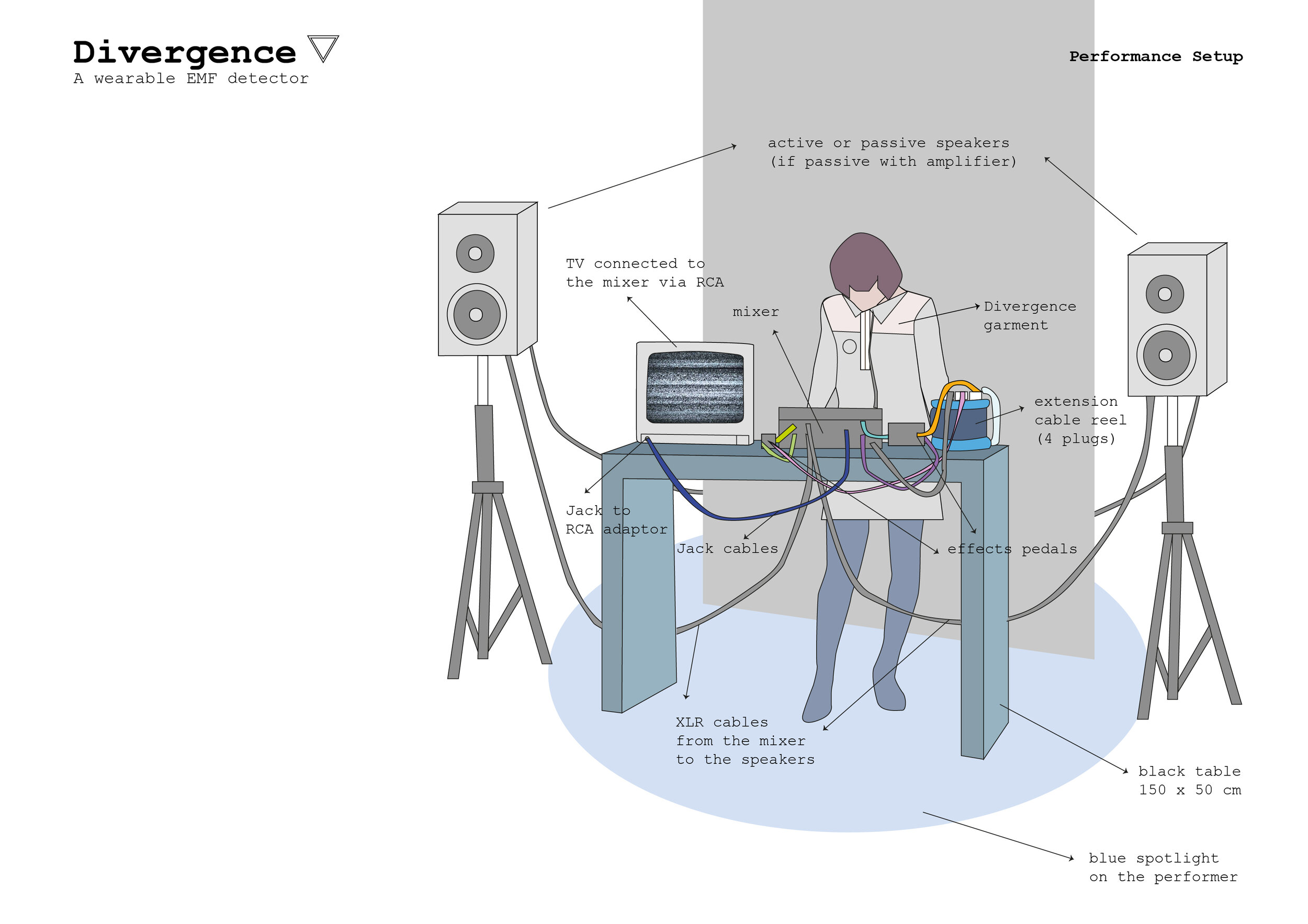


The Soft, The Hard, and The Wet residency documentation
Divergence was curated by Shulea Cheang, part of the Eleonora 2014 Residency The Soft, the Hard and the Wet that took place at STWST in Linz, Austria on June 2014.
During my two week residency on board the Eleonore boat I worked on creating a wearable prototype of an EMF (Electromagnetic Field) detector that will provide haptic and sonic feedback to the user that is wearing it. The wearable consists of a dress that has two handmade coils on the sleeves (inputs) that work as antenas for detecting electromagnetic sources, two vibration motors (outputs) and a mini jack (output) where the user can connect her headphones. These components are connected to an Adafruit Flora wearable microcontroller and programmed in the Arduino IDE in order to have the desired result.
I have started by setting up the lab with all the equipment that I would need: fabrics, needles, scissors, sewing machine, iron, fabric glue, conductive threads, conductive fabrics, enamelled copper wire for the coils, vibration motors, a zipper and a mini-jack, various microcontrollers, a breadboard, jumpers and crocodile clips, some resistors and some capacitors, pliers, a multimeter (to test my connections) and some cables and a soldering iron (for the connections that could not be made with conductive thread).
During the first days I have created the coils and the body of the dress so that I could start working on the soft circuit.
My next step was to test the coils in order to see how sensitive they where. For testing the coils I based my code on Aaron Alai's EMF detector project and Collin Cunningham's EMF experiments. I tested various resistors for their sensitivity and also calculated the resistance of the conductive thread that would be used for the soft circuit and decided to use a 3.6 M Ohms resistor on the ground connection of the coil and connected the other end to an analog pin.
I tested the values that I got by printing them on the Arduino IDE Serial Monitor and then added a speaker to have sonic feedback of what was going on. I used a "smoothing" technique of creating an array and calculating the average value (as the previous authors suggested) in order to filter any unwanted noise to the results and then I mapped the values to a range of frequencies between 20 and 880 Hz and their respected durations between 10 to 500 milliseconds. The frequency mapping in my script is inversed so that the higher the signal the higher the pitch and the lower the signal the lower the pitch. I got quite some interesting results as when I moved the coil closer to my mobile phone and the laptop I was getting lower frequencies and when I moved it closer to the plug where my laptop's transformer was I got higher and higher frequencies.
My next step was to create a zipper slider that would be used as a low-pass filter between the microcontroller and the mini-jack to provide the user with some kind of volume control for the headphones (and also filter any possible noise).
After experimenting with different materials and techniques I decided to go with Kobakant's "zipper slider", but instead of using resistive thread 66 Yarn 22+3ply 110 PET (4 K Ohms/20 cm resistance) and Lame Life Saver conductive thread, I have used Plug and Wear's resistive tape (3.2 K Ohms per linear meter/yard) form one side of the zipper and Spark Fun's Conductive Thread 60g (Stainless Steel) (28 Ohms/30 cm resistance) on the other side.
The side with the resistive tape is hooked up in the microcontroller and programmed to play a square wave 800 Hz tone, using the internal pull up resistor of the board, while the side with the conductive thread passes through a 47uF capacitor and ends at the speaker. Unzipping produces a higher pitch and when the zipper is completely open you get the highest pitch (in this case 880 Hz).
After the tests I started to construct the soft circuit using Spark Fun's Conductive Thread 60g (Stainless Steel) and an Adafruit Flora microcontroller. I also created stripes of fabric where I embedded the cables that connect the coils with the circuit.
Finally, I created the collar, where I incorporated the mini-jack with the 46uF capacitor that connects to the zipper to create the low pass/volume control slider.
For the complete schematics and code visit the GITHUB repository: https://github.com/afrdt/Divergence

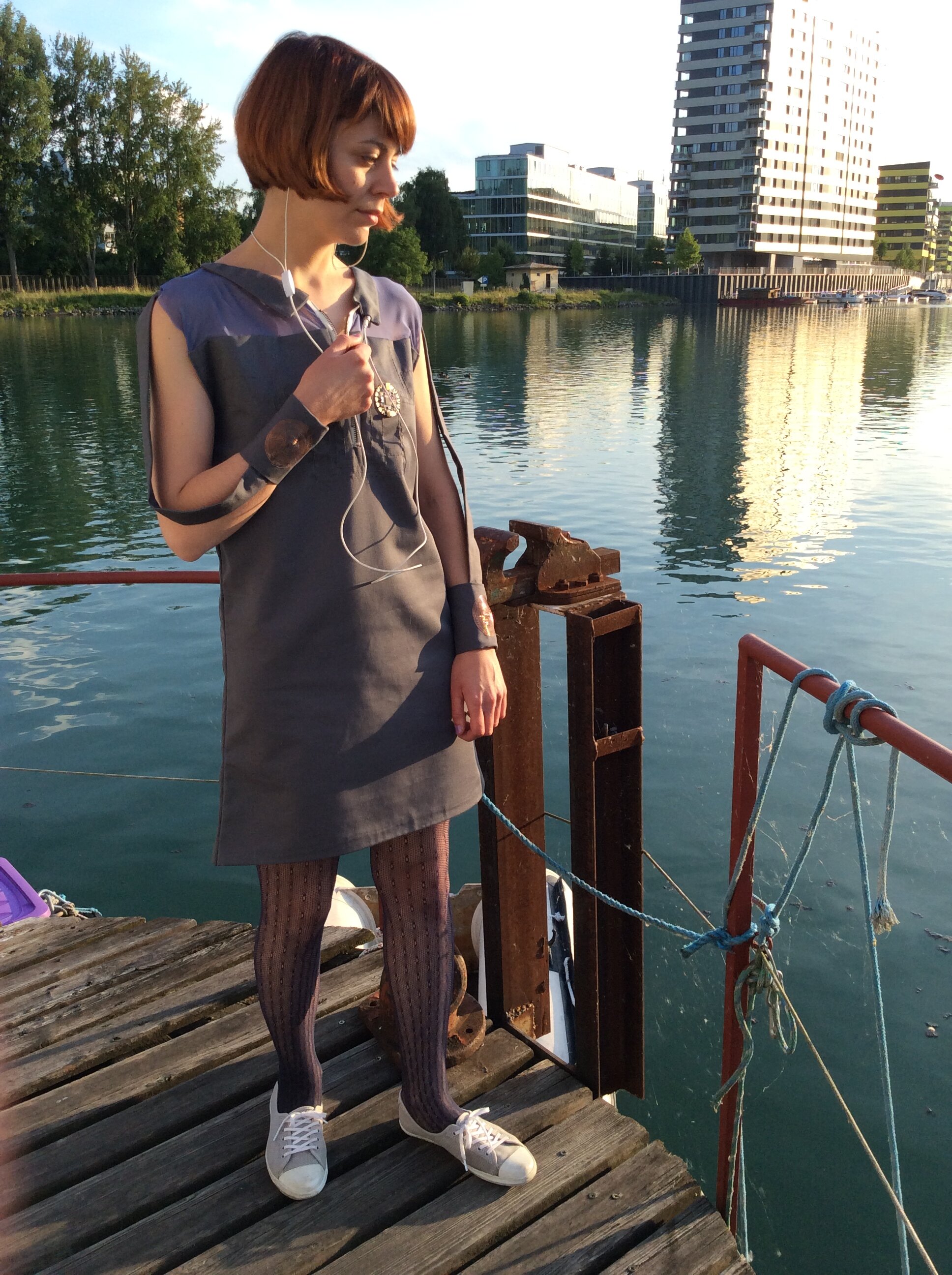
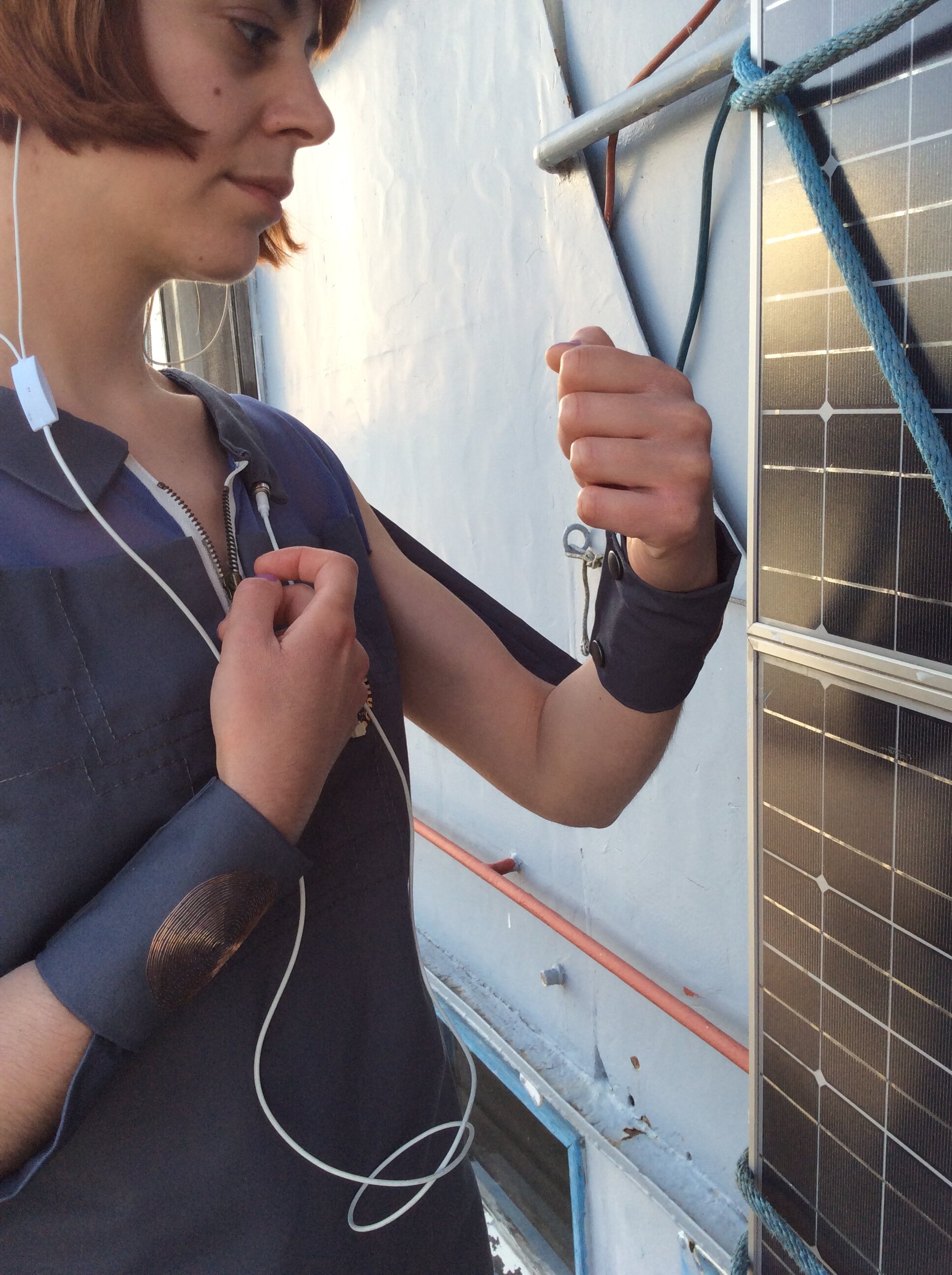

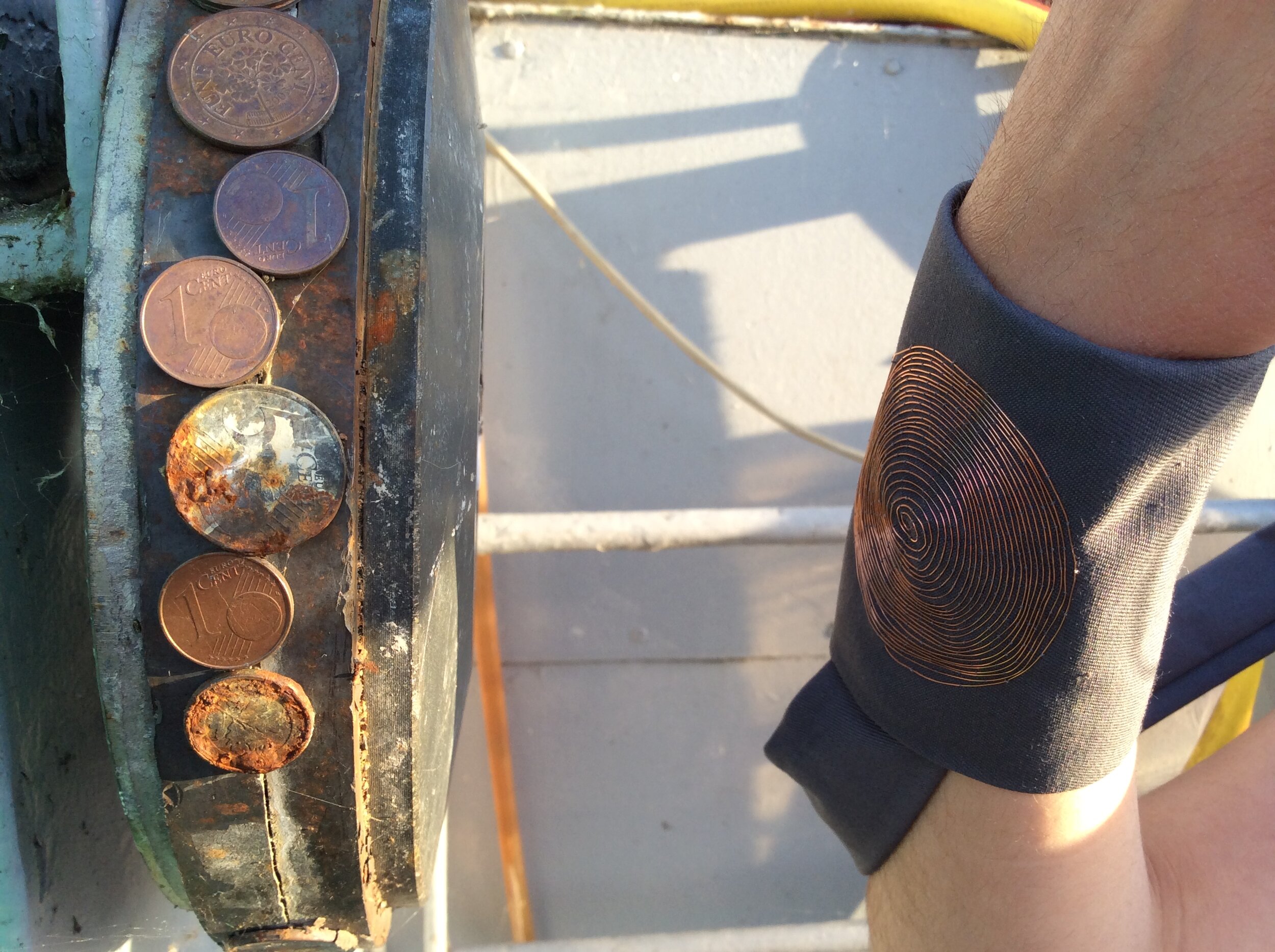

Workshops
The research into electromagnetic fields and wearables that was initiated in Divergence led to a series of workshops that explored different microcontroller-based soft-circuits, and various antenna designs.
The Electromagnetic Field Sensing workshop took place in April 2015 at the Bauhaus University in Weimar, Germany during the Future Vintage: The Textile Resistance program. The workshop encompasses the idea of intersecting science and art through e-textiles and wearables, by creating handmade technological artifacts that can sense electromagnetic fields. Throughout the duration of the workshop, the participants engaged in prototyping hand-crafted coils and designing their own interactive textiles by using embedded microcontrollers and actuators.
The aim of the workshop was to create a - light and sound - enhanced textile/wearable, that would provide sensory information on the invisible electromagnetic fields that surround us. The creation of these unique artifacts was intended to permit the participants to immerse their bodies in their surroundings through a playful exploration of art, tradition, and technology, and to provide a fertile field of experimentation towards future mythologies/methodologies of traditional handicrafts.
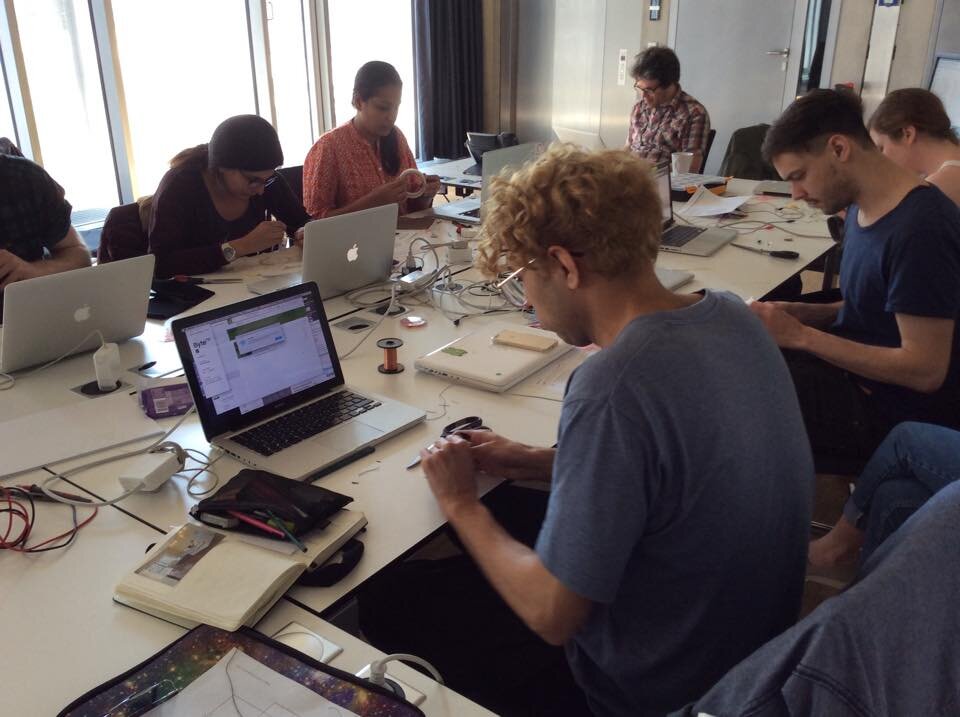










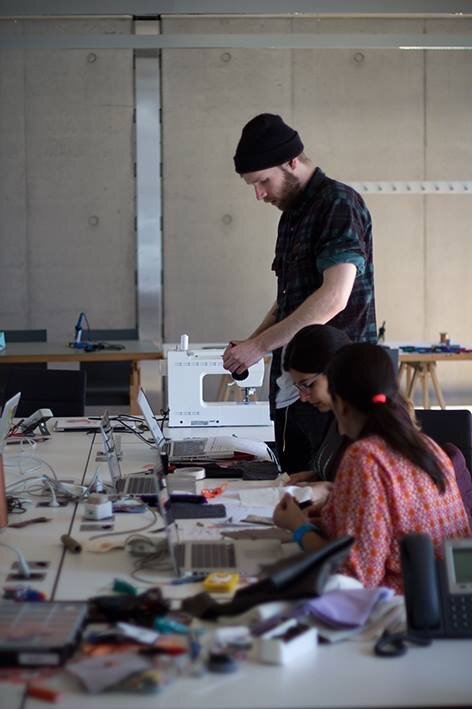



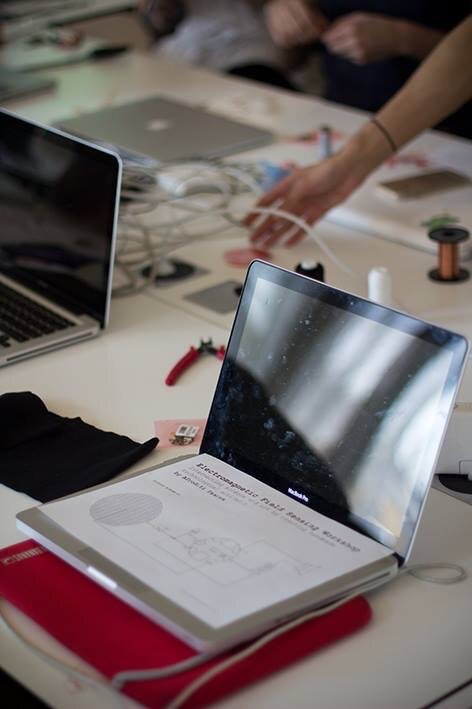
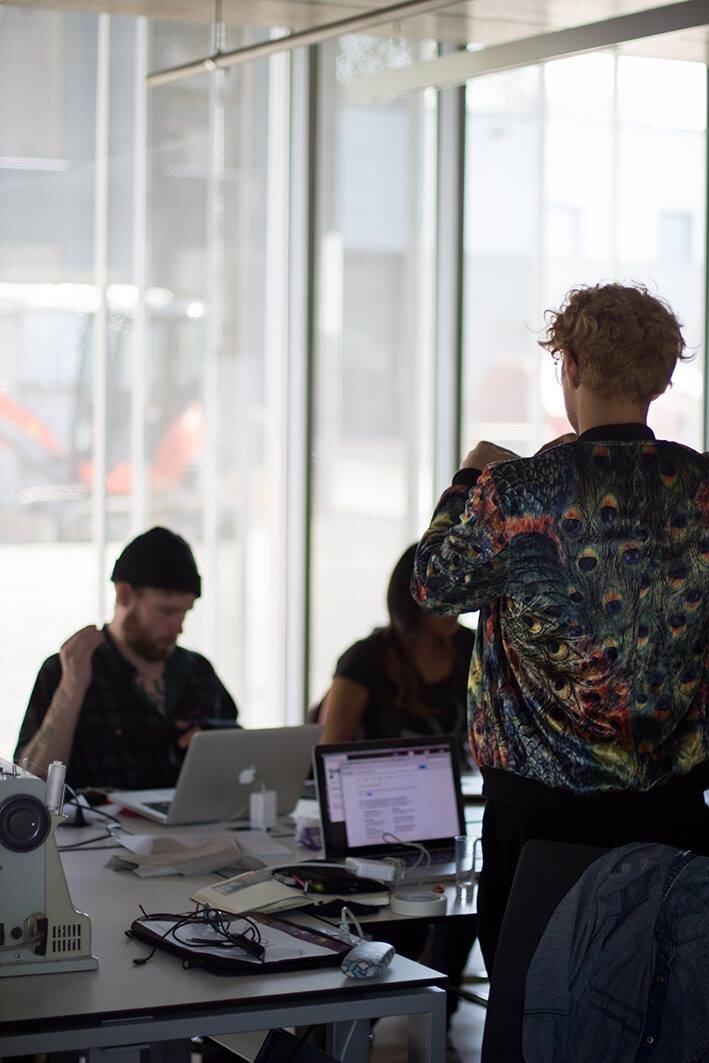


The Sensing EMFs Through Textiles workshop held by Afroditi Psarra and Martin De Bie took place during the eTextile SummerCamp in Paillard Centre d’Art Contemporain & Résidence d’Artistes located at Poncé sur le Loir in France on July 2016. The workshop encompasses the idea of intersecting science and art through e-textiles and wearables, by creating handmade technological artifacts that can sense electromagnetic fields. After a brief presentation of reference projects and technologies that would be used, the participants experimented with two different circuits. One acts as an amplifier that can pick up LF transmissions and make them audible. And the other, an ATtiny85-based detector, provides sonic, haptic, and visual feedback of the picked-up interference. Furthermore, the participants engaged in prototyping their own hand-crafted antennas using their desired crafting technique – embroidery, crochet, knitting, etc. The creation of these unique artifacts permitted the participants to immerse their bodies in their surroundings through a playful exploration of art, tradition, science, and technology.
For the full workshop documentation with circuit schematics and code check out: https://github.com/afrdt/WorkShop/tree/master/SensingEMFsThroughTextiles
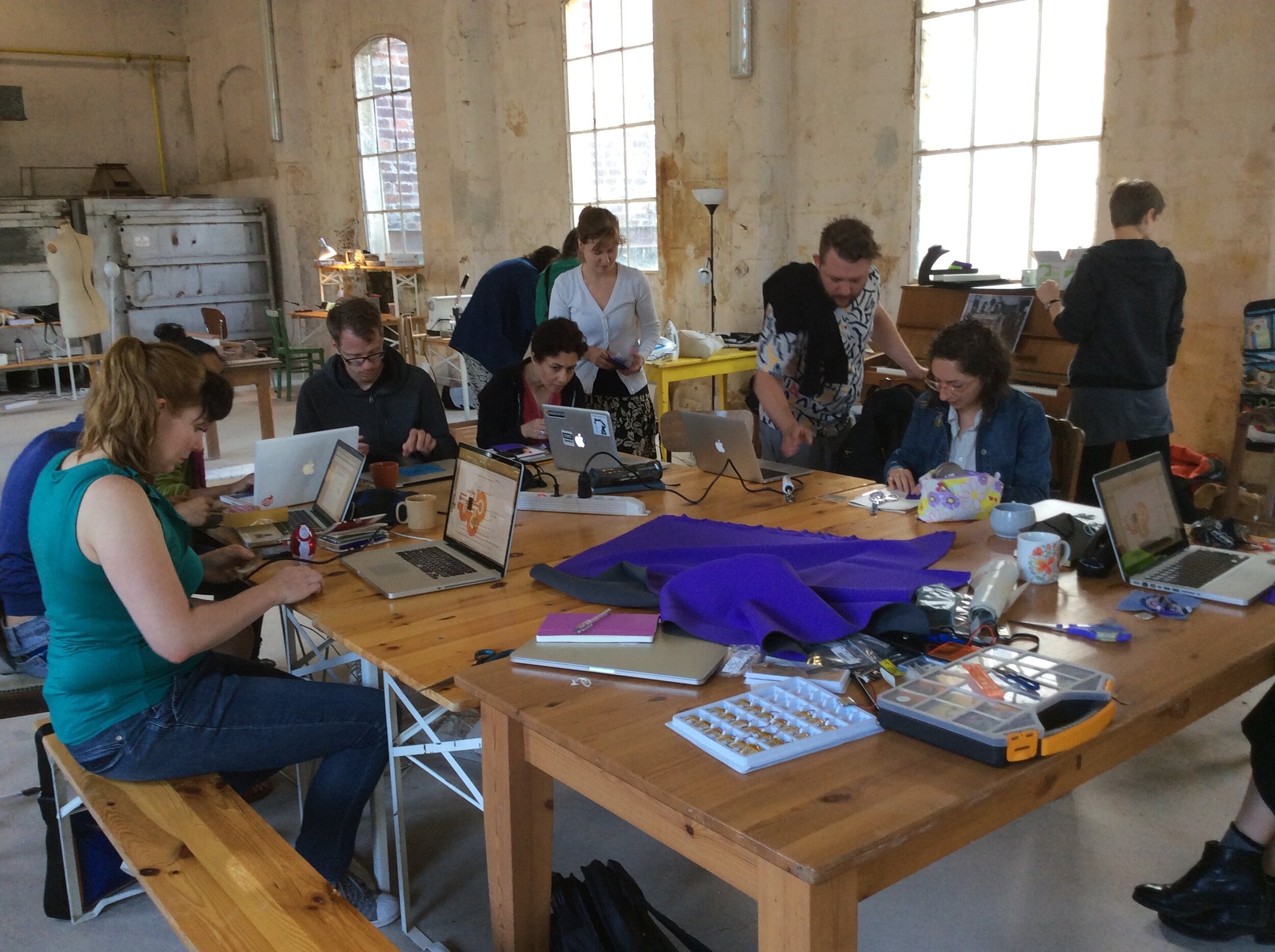









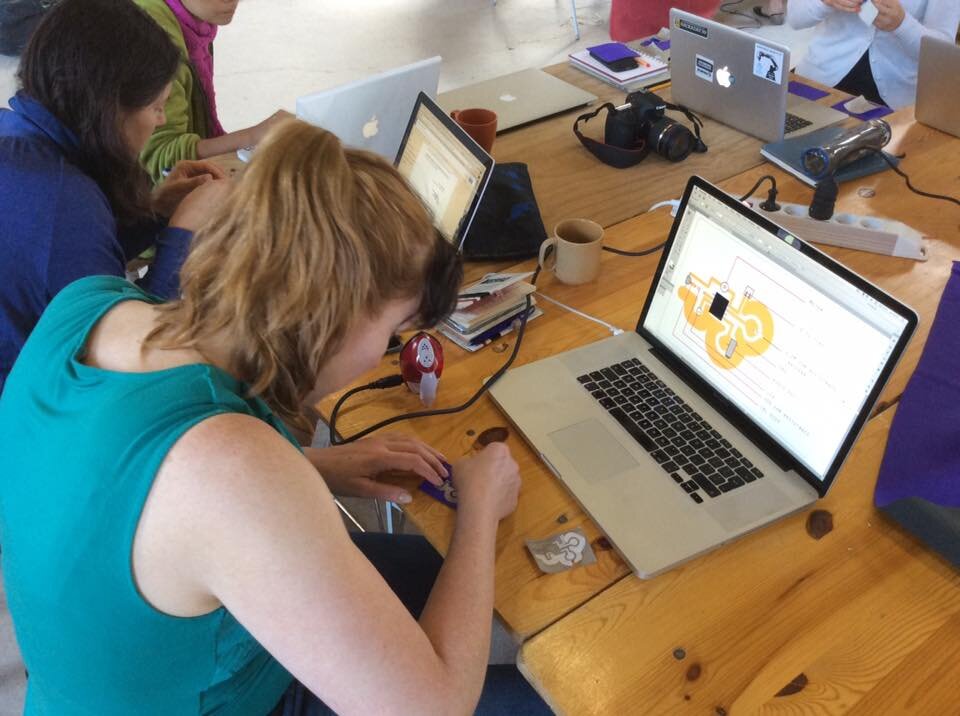


Exhibitions and Performances
2015
Adhocracy Onassis Cultural Centre, Athens, Greece. Curated by Panos Dragonas and Ethel Baraona Pohl.
2014
Rematerialising Culture Michael Cacoyannis Foundation, Athens, Greece. Curated by Margarita Kataga.
Phormix pres. NAUSEA 01 SpaceUnder, Athens, Greece.
Future Innovators Summit Ars Electronica C... What it takes to Change, Linz, Austria. Curated by Hideaki Ogawa.
The Soft, The Hard, and The Wet performances STWST, Linz Austria. Curated by Shu Lea Cheang.
Citations
Dragonas, Panos & Baraona Pohl, Ethel. 2014. Divergence. Adhocracy, adhocracy.athens.sgt.gr/divergence-2014-installation-and-sound-performance-with-e-textiles/
Press
Schächtele , Kai. “Elektrofaden - Strickhack Und Surrstick: Afroditi Psarra Vernaht Handwerk Und Computerkunst”, Jan. 2015, Wired Germany, issue 21, p. 24.
“Sense EMFs with This Dress #WearableWednesday.” Adafruit Industries - Makers, Hackers, Artists, Designers and Engineers!, 8 Oct. 2014, blog.adafruit.com/2014/10/08/sense-emfs-with-this-dress-wearablewednesday/
“The Soft, the Hard and the Wet.” Versorgerin, 23 Aug. 2014, versorgerin.stwst.at/artikel/aug-23-2014-2159/soft-hard-and-wet
Residencies
2014
Eleonora Residency The Soft, the Hard and the Wet STWST, Linz, Austria. Curated by Shu Lea Cheang.
Workshops
2016
Sensing EMFs through textiles at the eTextiles Summer Camp, Paillard Centre d’Art Contemporain & Résidence d’Artistes in Poncé sur le Loir, France. In collaboration with with Martin De Bie.
2015
Electromagnetic Field-Sensing at Bauhaus University - Future Vintage: The Textile Resistance Program in Weimar, Germany. Organized by Katrin Steiger, Martin Schneider, and Manuela Hornauer.






